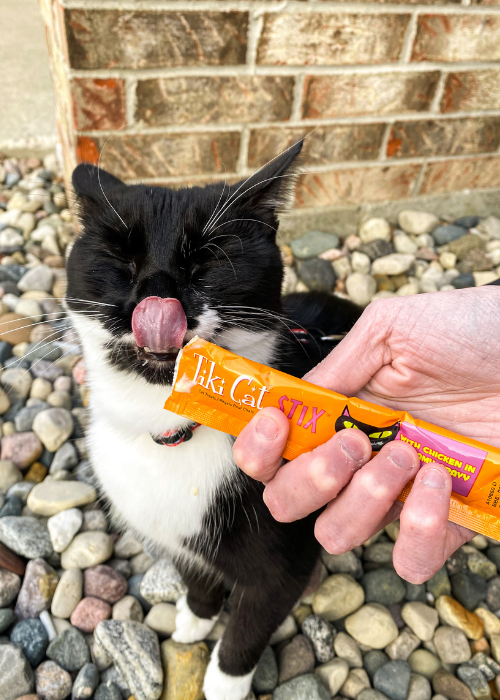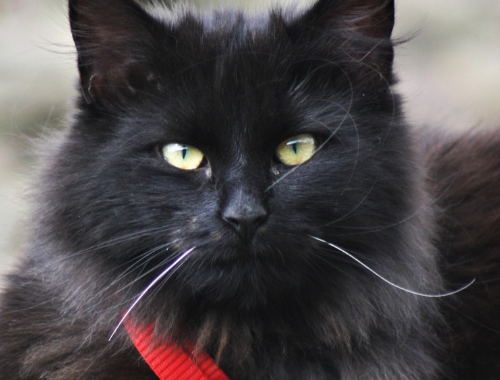
Best Tips For Training Your Cat If Not Food Motivated
When training cats, we often turn to food as a reward. While this works for many cats, what about the cats that just do not seem interested in treats? As a cat parent of 2 polar opposite cats – one that is a foodie, and one that does not care for food – we have found some tricks for training your cat who is not as food motivated. Clicker training can be a great addition to learning practical tricks outside. It can also be helpful in behavioral training. If you want to learn more about clicker training, check out our article here. Here are our top 5 tips on working to build food motivation or finding other ways to reward your cat.
Feed Small Meals Throughout The Day
Do you leave a bowl of food out for your cat to eat throughout the day? Free feeding a cat will reduce their food motivation. This style of feeding reduces the motivation because why work for food when they can get food for free. When food is not offered at all times, you can calculate what calories of your cat’s meal needs to be, and use some for treats during training sessions. If your working away from home, try using a timed feeder such as this one. Having them eat set meals can help stimulate their appreciation for food. This can help “teach” your cat to be food motivated.
Not All Treats Are Created Equal
If motivating your cat is the goal, look for irresistible treats your cat will love. Different situations call for different treats. If you are in an area that has more distractions, try tempting your cat with a special treat they do not usually get. This might give them the motivation they need to do what you want them to do. If you are in a quiet space with less distractions, maybe their kibble is all you need. Different cats like different treats, so it’s best to experiment. Try different textures and flavors for treats. Some cats like crunchy, some like soft and others like something that is lickable, such as Tiki Sticks.
Training your cat is all about finding what works best for them and using that to achieve the desired goal. If cat treats aren’t working, skip the cat aisle and go for small amounts of canned fish (in water with no added salt) or unseasoned, bland cooked meats. We recommend checking with your veterinarian before giving anything to your cat to make sure it is suitable for their specific dietary needs.
Try a Different Type of Food
When introducing new treats or foods to your cat, they may be skeptical and not want to eat it. This can be due to a lot of things, such as a different smell that your cat does not recognize as food anymore. To help ease the transition between new foods, try to select a similar protein to what they currently eat. If they are currently eating a chicken flavored food, try to keep it chicken flavored when you switch. This can help as it may have similar smells or tastes.
Pro tip: When first transitioning, it is best to add a small amount alongside your cat’s current food. This will allow them to see and sniff the new food but also allow them to eat their regular meal. Slowly add more of the new food and less of the old food with every meal over the course of several feedings. Keep at it until the new food completely replaces the old food. It is important to monitor your cats caloric intake so that they are still eating a sufficient amount for their daily requirements.
Make food delivery fun
Delivering the treat in a fun way can build your cat’s excitement towards food. One interactive way to make feeding fun is to place food or treats into a cat enrichment toy, such as these hunting mice feeders from Doc & Phoebe. Another option could be a Snuffle Mat. If you are looking for more budget friendly ideas, you can DIY by using an egg carton or ruffling up a blanket or towel and hiding treats in there. Not only are these food puzzles a great way to make it fun, but it also gives your cat mental stimulation.
Cats need mental stimulation throughout the day, and it can be just as tiring as physical exercise. Training your cat is a great form of mental stimulation, but interactive feedings that are not necessarily tied to training are great too. This can also help slow down your cat’s eating, if eating too fast is a problem for them sometimes.
Don’t Use Food
Some cats just won’t be food motivated no matter how hard you try, and that’s okay. If your cat is not motivated by food, try using toys or affection as a reward instead. By reinforcing positive behavior with things that they actually like, you will get a better result in the long run. Doing a quick play session in between training can keep your cat focused and keep them from getting bored. Test different toys and find out what your cat responds best too. Some cats respond to pets or attention as well. A little chin or butt scratch can help tell them they are doing a good job. Verbal praise works great for some cats too. Once you know what they respond best to, training your cat with that method will be much more effective.
Conclusion
All cats are different, and every cat responds differently to training. If training your cat is not going well because they are not motivated by food, it is important to find out why. Like we mentioned above, you can try switching up your cat’s eating habits or try different kinds of treats. Bigger tricks require bigger rewards, so test what your cat really loves to get them the motivation they need. Keep training fun by delivering the treats in interactive ways. But for some cats, you may also have to ditch the food altogether and find other creative ways to reward your cat. It is all trial and error. But once you find what works best, training your cat will become much more enjoyable for both you and them!
Disclaimer: This post is not intended to replace veterinary advice and we are not liable for any decisions you make for your cat. Some cats may need to be on special diets or avoid certain ingredients. Please consult with your veterinarian before making any changes to your cat’s diet. Also, never allow your cat to starve in order to switch their food or food motivate them, as this can have severe consequences to their health.

Meet Cordeilla
You May Also Like

Best Tricks To Teach Your Cat That Will Be Helpful Outside
May 28, 2021
Meet Cordeilla
July 2, 2021

